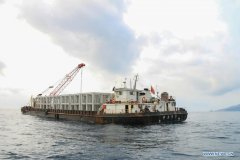EXPLAINER: Why Tonga eruption was so big and what's next
The eruption of the undersea volcano near Tonga over the weekend was incredibly explosive but also relatively brief
January 19, 2022, 12:35 PM
5 min read
Share to FacebookShare to TwitterEmail this articleFILE - This satellite image provided by Maxar Technologies shows an overview of Hunga Tonga Hunga Ha'apai volcano in Tonga on Jan. 6, 2022, before a huge undersea volcanic eruption. (Satellite image ©2022 Maxar Technologies via AP, File)
WELLINGTON, New Zealand -- People around the world looked on in awe at the spectacular satellite images of an undersea volcano erupting in a giant mushroom cloud in the Pacific. Many wondered why the blast was so big, how the resulting tsunami traveled so far, and what will happen next. New Zealand scientists Shane Cronin, a volcanology professor at the University of Auckland, and Emily Lane, a tsunami expert at the National Institute of Water and Atmospheric Research, help explain.
EXPLOSIVE BUT BRIEF
The eruption on Saturday was incredibly explosive but also relatively brief. The plume rose into the air more than 30 kilometers (19 miles) but the eruption lasted only about 10 minutes, unlike some big eruptions that can continue for hours. Cronin said the power of the eruption of the Hunga Tonga Hunga Ha’apai volcano ranks among the world's biggest over the past 30 years, and the height of the plume of ash, steam and gas was comparable with the huge 1991 eruption of Mount Pinatubo in the Philippines, which killed several hundred people.
WHY SO BIG?
The magma inside the volcano was under enormous pressure and had gasses trapped within it. A fracture in the rock likely induced a sudden drop in pressure, allowing the gas to expand and blast the magma apart. Cronin said the crater was sitting about 200 meters (650 feet) below the sea surface, a kind of Goldilocks depth for a big explosion in which seawater pours into the volcano and turns instantly into steam, adding to the rapid expansion and energy of the explosion. Any deeper and the extra pressure of the water would have helped contain the eruption.
FARFLUNG TSUNAMI
Many scientists were surprised that a single eruption could produce a Pacific-wide tsunami of about 1 meter (3 feet) that smashed boats in New Zealand and caused an oil spill and two drownings in Peru. Lane said that oceanwide tsunamis are usually triggered by earthquakes that extend across huge areas rather than from a single volcano, essentially a tiny dot in the ocean. She said other factors may have been at play, such as an underwater flank of the volcano collapsing and displacing water. She said one interesting theory is that the shock wave, or sonic boom, from the volcano that traveled twice around the world may have pumped more power into the tsunami waves.
TONGA MAINLY SPARED
Another mystery is why the tsunami wasn't bigger and more destructive in Tonga, which sits almost on top of the volcano.
“That's the million dollar question,” Cronin said. “Looking at the images so far, the level of devastation is less than I was fearing.”
Authorities by Wednesday had confirmed three deaths in Tonga, with concerns remaining about people on some of the hard-hit smaller islands. Dozens of homes were destroyed.
Lane said that Tongans at least got some warning, both from the increased activity at the volcano the day before the eruption and from the incredibly loud bang when it erupted but before the tsunami hit, allowing many to scramble to higher ground. She said reefs, lagoons and other natural features may also have protected parts of Tonga, while amplifying the waves in certain areas.
FALLING ASH
The ash that has coated Tonga is acidic but not poisonous, Cronin said. Indeed, he has been advising Pacific responders that people may still be able to drink from their rainwater supplies even if some ash has fallen in, which will make the water more acidic and salty. He said it was a question of applying the taste test and if water became scarce, it would be better drinking ash-tainted water than stagnant water that might be contaminated with bacteria. New Zealand and other nations are trying to get water and other supplies to Tonga as quickly as possible. Cronin said all of Tonga's soil comes from volcanic ash and the latest dump of ash would quickly wash into the ground and make the nation more fertile.
NO GLOBAL COOLING







